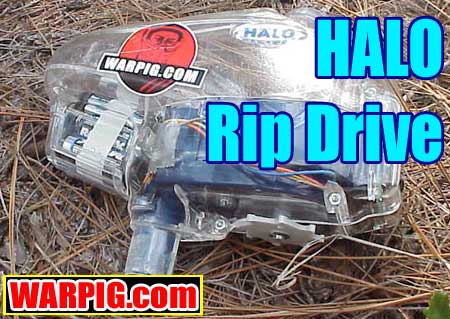  |
|
|
|
|
|
|
  |
|
|
|
|
|
|

What
do you think?
|

HALO Rip Drive by Bill Mills The HALO loader and its successor, the HALO B have certainly made their mark on tournament paintball. The HALO B is a constant pressure loading system. Its drive cone is linked to its gear and belt drive by a spring. The spring keeps a constant feeding pressure on the paintballs, so that the moment the paintguns breech is open another paintball will be driven into place. The motor then winds fresh energy into the spring when an infrared sensor detects that the paint has advanced into the paintgun. The constant pressure from the HALO B means that even at inhumanly high rates of fire, the HALO B keeps the paintgun fed with pant, and drives paint into the breech fast to avoid ball chops. There are a handful of side-effects from the spring and drive cone system used by HALO B. It is possible for the HALO B to occasionally jam. Its dual anti-jam prevents most potential jams, and many users report never having a jam, but it is an infrequent possibility. When the loader is turned off, and removed from a paintgun, it will still have a stack of balls in it under spring pressure, that can come pouring out. Also, if the loader’s batteries ever die during a game, it will not feed, unlike agitating loaders which can be shaken to unjam and feed. Odyssey Paintball has addressed all of these issues with the Rip Drive. The Rip Drive is a replacement for the loader’s main drive shaft. It is longer than the stock shaft, and has a thumbwheel that sits just below the loader body. Because the Rip Drive installation requires a precisely aligned hole to be drilled in the loader body, and a full disassembly and reassembly of the gear and belt drivetrain, Odyssey is installing the Rip Drive as a factory upgrade, or recommending that it be installed by the dealer through which it was purchased. The operation of the Rip Drive is simple. It is connected to the loader’s drive shaft. When the loader operates, the Rip Drive wheel can be seen to spin, an indication that the loader is functioning properly. Once the loader is empty, the wheel will be seen to spin continually, a visual indicator that it is time to reload. If a ball jam occurs, rotating the wheel backwards relieves the pressure so the jam can be shaken loose. Similarly, before removing the loader from a paintgun, the wheel can be backed up to take pressure off the drive spring.
On another note, while I was preparing for this review, I had a discussion with Chris Goddard from Odyssey Paintball about how the HALO works and what is in store for future versions of the loader. One of the things he commented on which I hadn’t understood previously was how the loader’s infra-red sensor worked. Most loaders using IR sensors (and breech sensors on electronic guns) put a beam of light across the feed path. When the beam gets through there is a gap in the stack of balls and the loader can then react to the gap by agitating, or delivering more paint with an impeller. In that set-up, the sensor basically delivers data in one of two states – on or off. In the HALO, the infrared system is reflective. A beam of infrared light is bounced off the surface of the ball in the stack. Rather than delivering simply an on or an off, the analog input from the sensor is converted into a digital value based on how much infrared light is reflected. Because different brands of paint have different reflective characteristics, the HALO’s circuitry does not look for a specific value, but rather a wave shaped pattern that occurs as balls move past the sensor. As a ball moves past the sensor, its bottom surface is angled to reflect very little light back to the sensor, as it moves toward the middle, the surface is nearly flat to the sensor reflecting back more light, and as it moves past, the upper surfaces are angled up reflecting back less light. It is this higher resolution sensing system that allows the HALO loader to know when it needs to drive its motor without having to wait for a gap in the stack of paint.
|
| Copyright © 1992-2019
Corinthian Media Services. WARPIG's webmasters can be reached through our feedback form. All articles and images are copyrighted and may not be redistributed without the written permission of their original creators and Corinthian Media Services. The WARPIG paintball page is a collection of information and pointers to sources from around the internet and other locations. As such, Corinthian Media Services makes no claims to the trustworthiness or reliability of said information. The information contained in, and referenced by WARPIG, should not be used as a substitute for safety information from trained professionals in the paintball industry. |